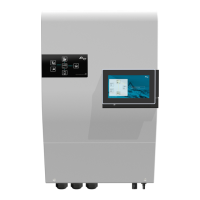Studer Innotec SA
next3
80 V 1.3 © Studer-Innotec SA next3 Tech manual
All the settings about this general behaviour are set during the “Wizard settings” process. For
details about individual settings see the AC-SOURCE section and Battery section of this
manual.
8.1.1.1 Comments about the State Of Charge (SOC) for backup
If the SOC for backup is set to 100%, the battery will be fully charged with the AC-source
(when available) with a target voltage following the cycle (for lead acid: absorption, floating,
…) or with the voltage given by the BMS.
If the SOC for backup is lower than 100% the charging may stop before reaching the target
voltage of the cycle. Voltage limits of the battery cycles are always used as boundaries in
any cases.
SOC for backup is modified in the battery configuration menu and is available to basic user.
It is possible to change it at any time.
8.1.1.2 Comments about the State Of Charge (SOC) for grid feeding
The principle of the SOC for grid feeding is that if the SOC is higher than this threshold, the
battery is discharged in the grid (if grid available and grid feeding allowed). After some time,
the SOC will be at the setting value and there will be no grid feeding from the battery
anymore.
The SOC for grid feeding can be used for
• Buffering peak solar production when grid feeding power is limited.
• Discharging the battery voluntarily for tests by a manual change of the parameter.
• Keep the battery at a lower SOC than 100% without losing the energy production
If the SOC for grid feeding is 100%, the battery voltage is maintained at the target voltage of
the cycle (for example absorption voltage).
When discharging the battery, the low boundary for voltage will be limited to undervoltage
level +2% higher. That means the battery will go down to the SOC you adjusted but keeping
that minimum voltage to reduce the discharging current.
The SOC for grid feeding must be set higher than the SOC for backup.

